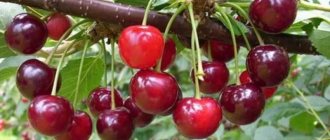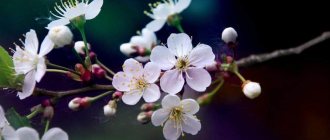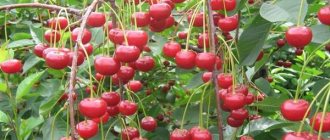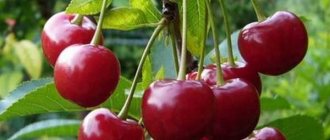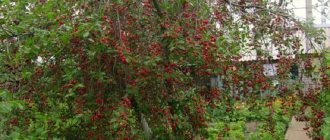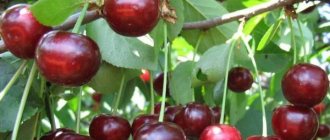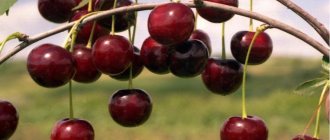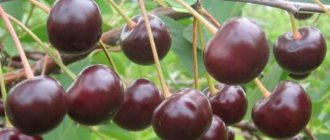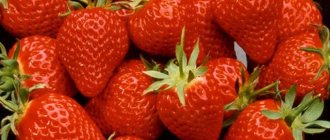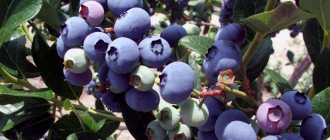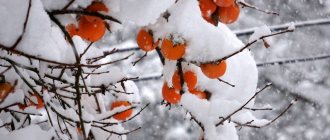History of selection
Strictly speaking, calling Bessey a cherry is incorrect. In terms of its biological parameters, it is much closer to the plum. It does not cross-pollinate with common cherry, steppe cherry and Bessey cherry, it does not cross, they cannot even be grafted onto each other. But there are many hybrids of the crop with plum and apricot. Bessey is usually classified as a microcherry (felt, ferruginous, etc.), when crossed with which many interesting varieties are obtained.
Bessey breeding is actively carried out in Canada and the USA. In our country, although Ivan Michurin paid attention to the culture, only V.S. Putov from the Siberian Research Institute of Horticulture named after him paid close attention to it. M. A. Lisavenko. Until his death, he worked on Bessey cherries and developed 5 elite forms with large sweet fruits: 14-29, 14-32a, 14-36, 14-36a, 14-40.
From time to time, varieties of sand cherries appear, obtained by modern breeders. Much more often, Bessey is crossed with other crops. The State Register includes 6 varieties of sand cherries:
| Variety name | Originator | Year of application/inclusion in the State Register |
| Watercolor Black | LLC NPO "Garden and Vegetable Garden", p. Shumovo, Chelyabinsk region. | 2017/2018 |
| Breeze | Same | 2017/2018 |
| Carmen | FGBNU Sverdlovsk SSS VSTISP | 2016/2018 |
| Severyanka | Same | 2016/2018 |
| Black Swan | Same | 2016/2018 |
| Relay race | Same | 2016/2018 |
Sand cherry Bessey would be an ideal rootstock for plums, apricots, and microcherries. But it has one significant drawback - poor anchoring. This means that the root of the crop weakly “clings” to the soil and an adult plant can tip over at any moment.
Important! You cannot graft other cherries onto Bessey: they simply will not take root.
Use of the variety in homestead farming
Bessey cherry is grown in garden plots as an ornamental plant or as a fruit crop.
Using shrub plantings, hedges are made. The bush is quite bright, the leaves are dark green with a bluish tint. During the flowering period, the plant is strewn with small inflorescences, ripe berries harmonize pleasantly with the greenery, and in the fall the foliage changes color to bright red.
If you are interested in purchasing Bessey specifically as an ornamental shrub, pay attention to the Pisarda variety. The hybrid was bred in 1910 by Niels Hansen, as a result of crossing Bessey sand cherry and cherry plum.
The shrub turned out to be short (no more than a meter) and unpretentious in care. The Purple Leaf Sand Cherry variety, which has dark purple foliage, is also interesting. It is cultivated in the USA, and over the past few years it has been winning the love of Russian gardeners.
The berries of the plant are also suitable for use as food, especially for compotes and jam.
Chocolate cherry: description, reviews from gardeners
15 best varieties of cherries for central Russia
- If you have problems with your back, joints and ligaments, you need it.
- An integrated approach to getting rid of protruding bunions on your feet
- Quick relief from varicose veins FOR only 1 RUBLE!
Very interesting article, I have never heard of this cherry variety before. Can you tell me if these cherries are suitable for canning and if they make good jam? I’m also interested in how quickly the shrub begins to bear fruit after planting?
Hello, Ekaterina. If you get a strong seedling, it will produce the first harvest in the second year. True, it’s insignificant, you can try it, but most likely you won’t be able to collect it for preservation. Good harvests, if all agricultural techniques are followed, can be expected in the third or fourth year after planting. Yes, the fruits are suitable for canning. There are recipes on the Internet for both Bessey jam and compotes. True, I didn’t have a chance to evaluate the taste. Most likely it will be an unusual jam, with a unique, tart taste. Judging by people's reviews, many people like jam from Bessey.
I remember the taste of this berry from childhood, we climbed into a friend’s garden, fell under the bushes of this cherry and ate, ate, ate! I don’t know what variety it was, but the berries were sweet, slightly tart (for comparison, bird cherry has a more tart taste) very juicy, and the compote made from them was amazing! Highly recommend.
Description of culture
As you can see in the photo of the Bessey cherry, it is a shrub 1–1.5 m high, up to 2.0 m wide. It grows in several trunks. Old branches are painted dark gray, young ones are red-brown. At first the shoots grow straight, then they droop, and by the age of seven they begin to spread along the ground.
The leaves of the Bessey cherry are somewhat similar to willow ones: the same elongated, lanceolate. Their length can reach 6 cm. The upper part of the leathery leaf blade is bright green, the lower part is grayish-silver. In autumn the bush turns red, which looks very beautiful.
Sometimes, even after the start of snowfalls, the cherry tree does not lose all its foliage.
At the end of spring, Bessey is literally covered with numerous flowers up to 1.5 cm in diameter, emitting a faint pleasant aroma. Sand cherry fruits are black, brown, and rarely greenish-yellow. Their shape varies from round to oval. The weight of the berries is up to 2 g, in selected specimens it is about 3 g. Delicate greenish, less often with reddish or burgundy veins, the pulp of Bessey is sweet, tart, sometimes astringent. There is sourness in the fruits, but it is barely noticeable. Sand cherry breeding is aimed at removing astringency.
Interesting! The taste of Bessey is not always related to the variety: it varies from plant to plant.
Pros and cons: is it worth planting on the site?
Advantages of Bessey cherry:
- high frost resistance;
- drought resistance;
- ease of care;
- undemanding to the composition of the soil;
- precociousness;
- high productivity;
- the ability to grow as an ornamental crop and for edible berries.
Cons of sand cherry:
- does not tolerate high humidity;
- specific (tart) taste of berries;
- With age, the shrub loses its decorative properties.
Characteristics
The characteristics of Bessey's sand cherry given by foreign sources cannot be relied upon. Varieties from the USA and Canada were not tested under our conditions.
Drought resistance, winter hardiness
Bessey cherry is a drought-resistant and frost-resistant crop. Its root system easily tolerates frost down to -26 °C. In the conditions of the American prairies, the above-ground part of the cherry can withstand up to -50 °C; in our climate, without shelter, you can count on Besseya to withstand -40 °C.
The difference is due to the fact that for sufficient ripening of wood, high summer temperatures are needed. At home, sand cherry grows in the steppe zone. We have forest, taiga and forest-steppe at the same latitude as in North America. There in the summer it is much cooler than on the prairies.
But Bessey’s cherry, even after freezing, quickly recovers. Young shoots grow from the root collar area, which produce a particularly bountiful harvest the following season.
Damping off is much more dangerous for Bessey. If the root collar is damaged, the cherry will die. Therefore, in winter it is recommended to periodically pierce the snow cover in several places with a sharp stick or metal rod.
Pollination, flowering period and ripening time
Varietal sand cherry is self-sterile. For species plants, it is necessary to have several specimens in the garden. Any other varieties of this crop can serve as pollinators for Bessey cherries.
It blooms late, for example, in the Barnaul area, by the end of May. Thanks to this, Besseya easily avoids return frosts. Sand cherry flowers are decorative and last for approximately 20 days. Fruiting begins at the end of August.
Productivity, fruiting
Besseya begins to bear fruit very early. Even on cherry seedlings, the first berries appear in the second or third year after germination. Fruiting occurs only on young annual shoots. They grow well exclusively on branches whose age does not exceed 5 years. Therefore, to get a good harvest, regular rejuvenating pruning of cherries is needed.
Important! Medium-length branches bear fruit best – from 15 to 50 cm.
The lifespan of Bessey cherry is 10–12 years. During this period, each bush is capable of producing up to 30 kg of fruit annually. It is noteworthy that they do not crumble at all. If you keep them on cherries in the warm autumn, the berries will wilt and only become tastier.
Area of application of berries
Bessey can be eaten fresh. But only varietal or selected specimens of cherries will produce tasty berries. If the fruits are tart, they can be used for jam, wine, juices, and compotes. Besseya is especially good in various fruit mixtures.
Resistance to diseases and pests
Sand cherry is remarkable in that it is almost not affected by diseases and pests. Only occasionally does she suffer from clasterosporiasis.
Advantages and disadvantages
Photos and descriptions of sand cherry characterize it as an exceptionally productive crop. In addition, the advantages of Bessey include:
- Annual fruiting.
- Resistance to diseases and pests.
- High drought resistance.
- Extremely extended fruiting period of the Bessey sand cherry. Its berries can even wither right on the bush, which makes their taste better.
- High frost resistance. It is superior to all other stone fruit crops.
- Ease of reproduction.
- Highly decorative plant.
- Early fruiting.
- Fast recovery after frost.
Disadvantages of culture:
- Short lifespan of cherries (up to 12 years).
- Small fruits.
- Low resistance to klyasterosporiosis.
- Bessey fruits do not have a very good taste.
- The instability of cherries to damping off.
Reviews of the Bessey cherry variety
According to reviews, Bessey cherry is indeed quite unpretentious, bears fruit well and is excellent for planting in the Moscow region. Its decorative qualities are also highly noted: both its spring flowering and the autumn redness of its leaves look very attractive. The leaf shape is more reminiscent of willow than cherry, the color of the leaves is green, slightly tinged with silver, which also adds unusualness and elegance to the shrub.
Where can I buy
You can buy Bessey cherry seedlings in our online store. We ship orders throughout the country using Russian Post. Order Bessey cherry seedlings.
Previous:
- Cherry Sister: description of the variety, reviews, characteristics
- Nedzvetsky apple tree: variety description, reviews, characteristics
- Ranetka apple tree: general description of varieties, reviews, characteristics
- Climbing rose Dorothy Perkins: some tips
- Perennials in the garden
Landing Features
Bessey's requirements for the location and planting conditions are not very different from other cherries. But there is a difference, and it cannot be ignored.
Recommended timing
It is best to plant Bessey in the spring, after the soil has warmed up a little. In places where summers are not too hot, container cherries can be placed on the site all season.
Choosing a suitable location
The main thing is that the place for planting the Bessey sand cherry is sunny, protected from the wind and does not get wet. Under no circumstances should it be placed in hollows or wetlands. The culture is very sensitive to damping off and stagnation of water at the roots. The ideal place for sand cherries would be a hill.
Any soil is suitable for Bessey: it grows even on alkaline soils. But it is best to plant it in soil rich in sand and organic matter.
What crops can and cannot be planted next to cherries?
When planting Besseyu on a plot, you need to remember that the crop is not tall - any tree can shade it. It is better to place other sand cherries nearby. Even under a mature tree, ground covers should not be planted.
There is no need for oak, birch, walnut, raspberry or sea buckthorn to grow next to Bessey. Neighborhood with black currant will not bring anything good to any of the crops.
Selection and preparation of planting material
If possible, it is better to grow planting material yourself. If necessary, seedlings are purchased from nurseries or garden centers that value their reputation.
The sand cherry root system should be well developed, and the shoots should be red-brown in color. The presence of cracks or other damage on the branches is unacceptable.
Landing algorithm
After a sunny, elevated place, protected from the wind, has been chosen for the Bessey cherry, you can begin planting.
- First, make a fertile mixture: combine the top layer of soil, humus, dolomite flour, ash and a handful of superphosphate.
- A planting pit is prepared measuring 40x40x40 cm. If the groundwater comes close to the surface of the soil, the depth is increased and broken red bricks and crushed stone are placed at the bottom and covered with sand.
It must be taken into account that the distance between the bushes should not be less than 2 m. Then Bessey is planted as follows:
- A layer of fertile soil is poured into the bottom of the hole.
- A seedling is placed in the middle.
- The cherry root is gradually covered with the mixture prepared in advance, constantly compacting it to avoid the formation of voids.
- After planting, a roller of soil is formed around the bush and watered abundantly.
- The tree trunk circle is mulched.
How to properly care for sand cherries
Despite the fact that Bessey cherry is absolutely unpretentious, following simple rules for planting and caring for it will help you grow healthy and strong plants that will constantly delight you with generous productivity. Caring for the crop will not take much time, because even if you don’t water the bushes for several days, the plant will not go to waste, as it has excellent drought resistance. The culture is not sensitive to low temperatures and has excellent immunity against most plant infections.
Important! Due to the fact that besseya is a self-fertile crop that does not require additional manipulations, to increase productivity it is necessary to plant several bushes nearby
Watering rules
When growing sand cherries, you should not rely on their natural hardiness and expect that the plant can do without watering at all. Lack of moisture sharply reduces crop productivity. Organizing high-quality watering is especially important at the stage of fruit formation: bushes that chronically lack moisture produce smaller fruits.
Cultivating bessey in conditions of high humidity is no less dangerous, as this can cause the bushes to be damaged by mold infection. It is necessary to water the bushes when the top layers of soil have already dried well to a depth of several centimeters, and also if, when you try to compress a lump of earth taken from under the bush, it falls apart and does not hold its shape.
How to care for the soil
In order for Besseya to grow and develop well, the bushes need simple agrotechnical measures:
systematic weeding of the tree trunk area and removal of weeds;
- loosening the tree trunk zone to improve the aeration characteristics of the soil;
- timely watering;
- periodic soil fertilization.
Tips for fertilizing Bessey cherries
Fertilizers are applied in early spring, before flowering begins. During this period, it is recommended to introduce potassium or nitrogen-containing fertilizers into the soil, which will stimulate the development of greenery and enhance the growth of bushes. During the vegetative phase and flowering, you can treat the plant with a solution of mullein and ash, which will contribute to the formation of larger fruits. After harvesting, before the onset of cold weather, you can increase the protective forces of plants by adding complex fertilizers to the soil.
How to protect cherries from pests and diseases
In its natural environment, sand cherries very rarely suffer from disease. However, when cultivating a plant in conditions of high humidity, the likelihood of plant infection with fungal phytoinfections significantly increases.
Following simple rules will help prevent the development of fungal infections:
- removal of fallen leaves from the site in the autumn;
- regular pruning of all damaged shoots;
- treating plants with a 3% solution of ferrous sulfate before flowering;
- spraying the bushes before buds open with a 1% solution of Bordeaux mixture;
- treatment of gum wounds with garden varnish.
Bessey cherry very rarely suffers from pest attacks; the thing is that at the flowering stage the plant emits an intense aroma that insects do not really like.
Rules for pruning sand cherry
Pruning sand cherries is virtually no different from pruning other fruit and berry crops. Pruning bessey is the most important activity that allows plants to develop properly and preserve their ability to bear fruit for as long as possible.
Important! Remember that old branches of cherry cherry that have reached the age of six will produce much less harvest, and their fruits will be smaller and tart
Basic rules for forming Bessey cherry bushes:
- in the first year of life of seedlings, the shoot is cut 5–10 cm from the top;
- periodically remove branches from the plant that have reached four years of age, since it is the young shoots that bear fruit generously;
- Increased budding is observed in shoots reaching a length of no more than 50 cm, and therefore try to leave branches of this particular size on the bushes.
Subsequent care of the crop
Young plants must be watered. Adult Bessey is a drought-resistant crop. It is important not to overdo it with watering. In the spring, cherries are fertilized with nitrogen, in the fall with potassium and phosphorus, the latter element being added in small doses. It is best to mulch the soil for the winter with humus mixed with ash: it contains all the elements Bessey needs for growth and fruiting.
Sand cherry needs regular pruning. When planting, it is shortened, leaving 5–10 cm. It will quickly grow with young shoots. Branches 4–5 years old are completely removed. When doing sanitary and lightening pruning, you need to take into account that the most productive shoots are 15–50 cm long. These are the ones that need to be left.
Besseya practically does not produce shoots. Until the branches lie on the ground, the soil needs to be loosened and weeds removed.
Only where severe frost is possible (below -50 °C), and there is almost no snow, are cherries covered with spruce branches for the winter. The crop is susceptible to damping off, so the snow must be regularly pierced to the surface of the soil in several places to ensure ventilation.
Diseases and pests, methods of control and prevention
Reviews from gardeners about Bessey's cherry characterize it as a crop that is resistant to disease and almost not susceptible to attack by pests. Only in cold, rainy summers can she suffer from cleasterosporiasis. To prevent the disease, spray it twice with Bordeaux mixture (1%) - on a green cone and immediately after flowering. Sanitary pruning and cleaning of fallen leaves should not be neglected.
Resistance to weather vagaries, diseases and pests
Besseya is resistant to frost and prolonged drought; it can be planted in regions with different climatic conditions. But in severe frosts in winter, it is recommended to protect the bush with agrofibre.
Diseases occur rarely, and for the following reasons:
- water stagnation;
- lack of regular loosening and weeding;
- heavy or clay soil;
- lack of sunlight.
Due to high humidity and frequent rains, the infectious disease clusterosporiasis or perforated spot develops. Treatment - treating the bush with Bordeaux mixture before and after coloring.
Attention! Bessey can be attacked by the cherry fly, due to which the crop becomes significantly smaller and spoils.
Insecticides are used to protect shrubs from insects
What are the methods of reproduction?
Even a novice gardener can cope with the propagation of Bessey cherries. Since it practically does not produce root shoots, you can try other options:
- Plant the seeds. They have excellent germination. They are planted immediately after eating cherries, or after stratification for 2–3 months.
- Both green and woody cuttings take root well. They are grown for 1–2 years before being planted in a permanent place.
- The easiest way to propagate Bessey is by layering. They are simply dug in and secured with a metal bracket so that when picking berries or weeding they are not accidentally pulled out of the ground. The next year, the young cherry is separated from the mother plant and planted in a permanent place.
The nuances of growing shrubs, planting and care
Features of planting a cherry bush:
- Plants with an open root system are planted in spring, and plants with a closed root system in summer or early autumn. From the second week of autumn, planting is not carried out.
- 2 weeks before planting, a hole is dug and drainage - pebbles or crushed stone - is poured into it. The soil in the hole is mixed with sand.
- A nutrient mixture is added to the hole - humus (2 buckets), superphosphate (800 g) and ash (200 g). A hill is formed from the resulting mixture.
- After the soil settles, a seedling is inserted into the mound of fertilizer, the root system is straightened, and the hole is filled with earth.
- The plant is watered with water containing mineral fertilizer diluted in it.
Attention! For planting, it is recommended to choose plants over 1 year old.
You need to care for the bush in the same way as for an ordinary cherry. Watering is carried out 3 to 5 times per season. Fertilizer application:
- potassium compounds are used;
- if the growth of the bush begins to slow down, nitrogen supplements are used;
- foliar feeding - irrigation with nutrient compositions is carried out three times per season.
Complex fertilizers are applied in the spring, and in the fall the soil around the bush is dug up with compost and humus added.
Bessey has no root shoots, which greatly simplifies care procedures.
Suitable soil
When choosing soil and planting site, you must be guided by the following rules:
- the bush loves well-lit areas;
- The plant should not be planted in lowlands where water accumulates after watering or precipitation; areas where groundwater lies high are not suitable;
- soil - should be light and loose, if the soil is heavy, add drainage;
- pH level - medium or low, if the soil is acidic, dolomite flour is added to it;
- in the case of clay soil, it is mixed with sand.
Additional Information! The best growing environment for microcherries is non-acidic, sandy, light soil.
Reproduction
Reproduction by seeds or layering. The seeds have high germination rate.
To propagate by layering, the branch must be bent to the ground, secured with a bracket and covered with soil. Rooting occurs quickly. After the root system is formed, the branch is cut off from the mother bush and transplanted to a permanent place.
The disadvantage of growing a bush from a seed is that the resulting bush will retain the qualities of only one of the parents, which will negatively affect the taste of the fruit.
Reproduction scheme by layering
Crown formation, pruning
Pruning is the main procedure that must be carried out according to the following rules:
- early spring - shoots that thicken the bush are removed;
- Branches older than 7 years must be removed, as they do not bear fruit well;
- spring sanitary pruning - removal of dry and damaged shoots.
By pruning, you can give the bush any shape - pyramidal or sloping.
Attention! If the cherry tree begins to dry out, it can be revived by cutting off all the branches, leaving a small stump. Soon young shoots will appear from it.
Grafting on ordinary cherries
Besseya is not inherently a cherry. It is not grafted onto an ordinary cherry tree, because such grafts will not take root. The shrub is closer to the plum tree, with which grafting is possible.
Harvesting and processing
Bessey can be harvested at any time after ripening: the fruits do not fall off and become tastier when ripe. The main thing is that the berries do not get dirty. To do this, you can lay agrofibre or cut grass on the ground. Some gardeners arrange special supports so that branches generously strewn with fruits do not lie on the ground.
Bessey berries are processed in the same way as plums: they are quite similar in composition. It is best to add them to jams, compotes, juices and wine from other fruits - sand cherries will give them a special color and aroma.
Growing Bessey sand cherries is possible even in regions where other stone fruit crops cannot survive. Perhaps its taste is unique and not everyone will like it, but a large amount of vitamins and other healing substances makes the berries not just a delicacy, but a useful addition to our diet.
Beneficial features
Not everyone loves bessey berries. However, the culture has all the healing qualities in comparison with its usual varieties. Its fruits contain valuable macro- and microelements, folic, organic acid, pectin and tannins, sugars, as well as vitamins PP, C, B1 and B2. Traditional medicine experts claim that the berries of such cherries have an astringent, general strengthening and anti-inflammatory effect, and improve the functioning of the gastrointestinal tract. They can be used to make wines, compotes, liqueurs, jams and syrups.
The sand cherry is very unusual and attractive for any amateur gardener. Planting and caring for it does not take much time, but on the contrary, it only brings incredible pleasure and joy.
Advantages and disadvantages
The main advantages of the Bessey variety include:
- resistance to frost;
- resistance to periods of drought;
- propagating this cherry is so easy that even novice gardeners can cope with it;
- resistance to most diseases and pest attacks;
- stable yield every year;
- the tree does not form basal shoots;
- Bessey has high yields for mini cherries.
The disadvantages of this stone fruit tree include the following:
- not too long fruiting period - up to 12 years;
- at high temperatures and humidity, the tree may rot;
- The taste of the fruit is not very common for cherry trees and is more similar to the taste of bird cherry berries.
What conditions does culture require?
Bessey cherry can be planted on a mound, a low hill or on its slope. In lowlands where water will accumulate after rain, it is better not to plant shrubs. On swampy soils, cherries will rot and rot.
Climate
For sand cherries, well-lit, elevated areas protected from northern winds are suitable. The shrub can grow in any climatic zone of Russia. Microcherry blooms late, it is not afraid of spring frosts, and a good harvest of berries can be obtained even in the northern regions. Bessey cherry adapts well to any conditions.
Suitable soil composition
Bessey cherry grows well on sod-podzolic, chernozem, and forest soil. Does not tolerate acidic soils. It is advisable to lime the soil before planting. If the acidity of the soil is unknown, the soil can be treated with dolomite flour. This additive will not harm the cherries, but will reduce the acidity of the soil. On acidic soils, microcherries will often get sick.
For shrubs, sandy, sandy loam or loamy soil of neutral acidity is suitable. Too clayey soil can be diluted with sand. To poor soil - add a bucket of humus or compost.
What to plant next
In the garden near the Bessey cherry you can plant plums, apricots, almonds, sloe, and other varieties of sand cherries. It is advisable to plant trees and shrubs at a distance of 2-3 meters from the microcherry. It is better not to plant bushes with gooseberries, raspberries, and sea buckthorn near the Bessey cherry. The roots of these plants will spread throughout the garden and intertwine with each other.
Care instructions
Old branches that have already bent to the ground must be removed immediately. Otherwise, they will take away a lot of nutrients. After removing the old ones, new branches will begin to actively grow. The gardener makes sure that the Bessey variety of cherries does not thicken. Regular cutting of interfering shoots in mid-spring will help with this. When choosing fertilizers, attention is paid to the growth rate. If it is insufficient, then nitrogenous fertilizing is applied. If there are no delays from the time frame, it is better to opt for potash fertilizers.
Important! Complex nutrients are applied no more than 3 times during 1 season.
The optimal method of application is spraying. Increased attention is paid to disease prevention and pest control. Gardeners are advised to stop using chemicals, otherwise a large amount of it will accumulate in the cherry. If there are no traces of disease, then biologically active substances are used for preventive purposes. Gardeners carefully monitor regular watering. In hot weather, water is applied to the soil 2-3 times a week. Before watering, check the degree of soil moisture. Compliance with the “golden mean” guarantees high yields.
Fruit shape and weight
Big cherry
The size of the fruit is divided by the size of the cultivated varieties of cherries:
- large - with a mass of more than 5 g. These include Jealous, Drogana Zheltaya, Tyutchevka, Iput, Raditsa, Sadko;
- Medium (3-5 g);
- Small (up to 3 g). The berries of these varieties are more like large cherries, but have a sweet taste. The early pink, Leningrad pink and Leningrad pink varieties are varieties with small berries.
The berries are usually round in shape, but there are heart-shaped varieties that are slightly flattened on the sides.
Usually the berries are divided into bagaro and guinea depending on the hardness of the fruit. If the fruits are soft, delicate, with thin skin that quickly leaves traces of touch, pressure, light blows against each other - then the variety of guineas is at stake. As a rule, these are early ripening berries. You will enjoy these trees with flowers and first berries until the end of May, but these varieties are poorly kept in good condition, almost transportable.
Bigarro - thick berries with cartilaginous meat, with veins, have high industrial value, as they can be widely used for long-term storage, adapted for transportation, preservation and production of dried fruits.
In the following video you will learn how to grow different varieties of cherries on a tree and how to vaccinate them using the improved copulation method:
Page 5
Translated from Latin, the name cherry means “cherry tree.” Because not only people, but also birds appreciated the taste of these berries. Only in Russian, cherries and cherries have different names; in English-speaking countries, the berries have the same name - Cerasus, only cherries are marked with the nickname "sour", and cherries - "sweet".
But besides the sweetness of the taste, cherries have two more important benefits:
- Cherry trees are harvested every year, and they do not have fruit periodicity like cherry trees;
- On average, sour cherries produce twice as many berries as sour cherries - up to 25 kg per tree.
There are many different varieties of cherries, in this article we will focus on one of the most popular varieties of black candies.
Cherry fruiting period
Culture bears fruit early. In the second, and in extreme cases, in the third year, the low-growing shrub is covered with beautiful flowers, which later grow into round fruits. Cherry berries begin to ripen in the last month of summer. They stay on the branches for a long time, so they can be removed over a long period. After ripening, the berries do not fall off. They only slightly wither right on the branches, acquiring a brighter and more pleasant taste.
Time to Harvest: Tips
The berries are removed in several stages. The gardener does not have to collect them from the ground, because the Bessey variety does not fall off on its own. Only whole and ripe fruits are subject to long-term storage. Once placed in plastic containers, they are placed in a cool place away from sunlight. Do not close the container tightly. The presence of a constant flow of oxygen and a moderate level of humidity is a prerequisite for maintaining their ripeness. If you put cherries in the refrigerator, then the “Bessey” variety will stay there for a maximum of 14 days.
If desired, the berries can be frozen or dried. In the second case, the cherries are placed on a baking sheet and placed in the oven at a temperature of +30C. The duration of heat treatment is 10 minutes. Do not close the oven doors, otherwise the cherries will burn. The dried product is placed in a jar.
